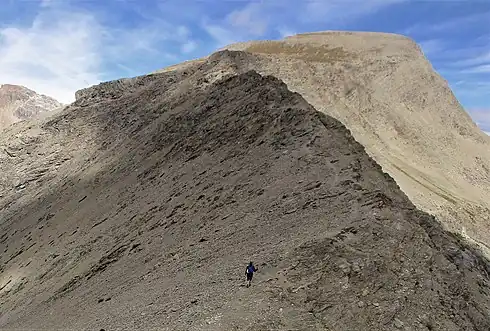Nub Peak
Nub Peak is a 2,746-metre (9,009-foot) mountain summit located in Mount Assiniboine Provincial Park, in the Canadian Rockies of British Columbia, Canada. Its nearest higher peak is Nestor Peak, 4.0 km (2.5 mi) to the west.[1] The mountain is situated north of Sunburst Peaks, with Elizabeth Lake and Cerulean Lake in between. The Continental Divide and Assiniboine Pass are situated 3.5 km (2.2 mi) to the east. Nub Peak is famous for its panoramic view of Mount Assiniboine with its surrounding lakes and peaks. The mountain's descriptive name was officially adopted in 1924.[2][4] An arm extending southwest from Nub is officially known as Chucks Ridge, and an arm extending southeast is officially called Nublet. Nub Peak is composed of sedimentary rock laid down during the Cambrian period and pushed east over the top of younger rock during the Laramide orogeny.[5]
| Nub Peak | |
|---|---|
 Nub Peak | |
| Highest point | |
| Elevation | 2,746 m (9,009 ft)[1] |
| Prominence | 121 m (397 ft)[1] |
| Parent peak | Nestor Peak (2,972 m)[1] |
| Listing | Mountains of British Columbia |
| Coordinates | 50°55′59″N 115°39′28″W[2] |
| Geography | |
 Nub Peak Location of Nub Peak in British Columbia  Nub Peak Nub Peak (Canada) | |
| Location | Mount Assiniboine Provincial Park British Columbia, Canada |
| District | Kootenay Land District |
| Parent range | Park Ranges Canadian Rockies |
| Topo map | NTS 82J13 Mount Assiniboine[2] |
| Geology | |
| Age of rock | Cambrian |
| Type of rock | sedimentary rock |
| Climbing | |
| Easiest route | Scrambling[3] |
Climate
Based on the Köppen climate classification, Nub Peak is located in a subarctic climate zone with cold, snowy winters, and mild summers.[6] Winter temperatures can drop below −20 °C with wind chill factors below −30 °C.
See also


References
- "Nub Peak". Bivouac.com. Retrieved 2019-03-23.
- "Nub Peak". Geographical Names Data Base. Natural Resources Canada. Retrieved 2019-03-24.
- "Nub Peak". explor8ion. Retrieved 2019-03-27.
- "Nub Peak". cdnrockiesdatabases.ca. Retrieved 2021-05-27.
- Gadd, Ben (2008), Geology of the Rocky Mountains and Columbias
- Peel, M. C.; Finlayson, B. L.; McMahon, T. A. (2007). "Updated world map of the Köppen−Geiger climate classification". Hydrol. Earth Syst. Sci. 11: 1633–1644. ISSN 1027-5606.